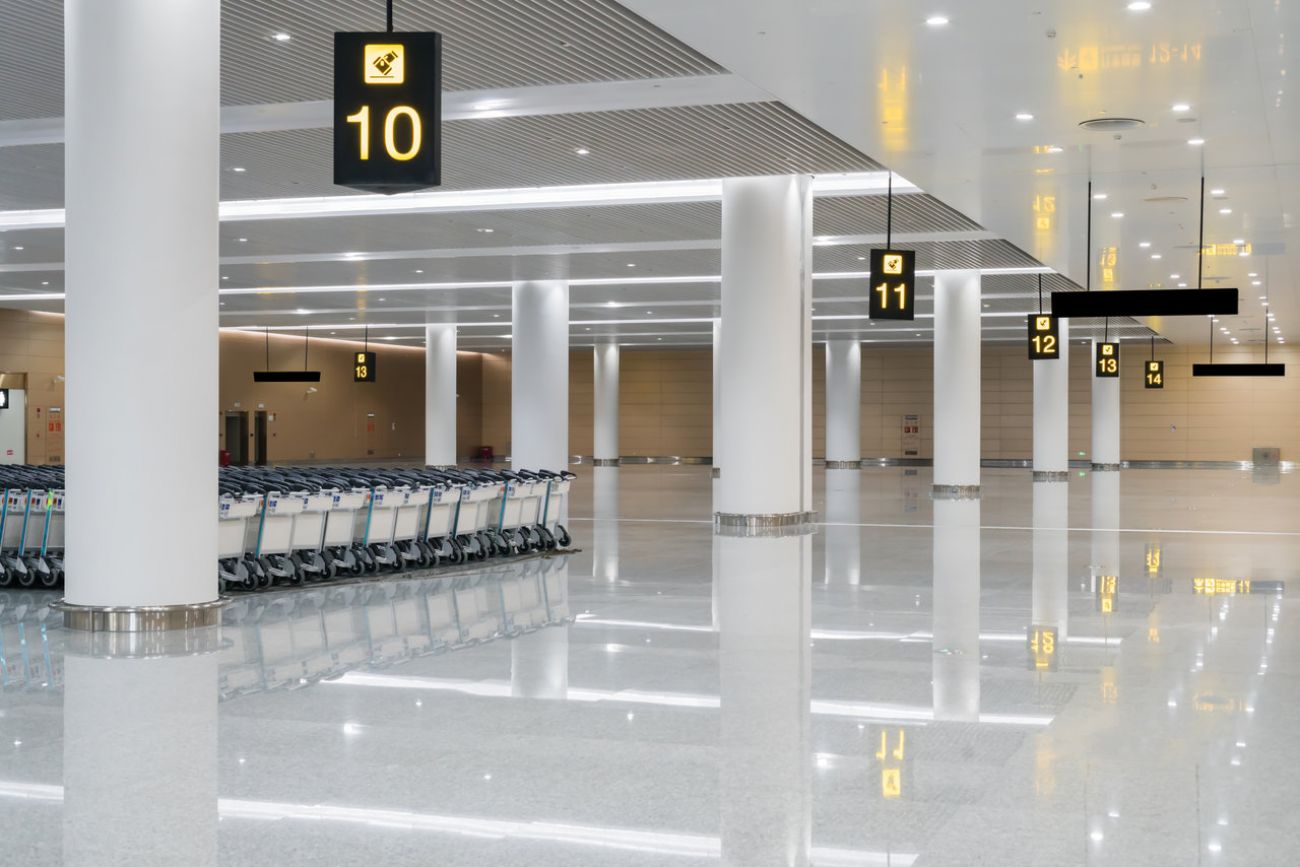Coronavirus air travel: a postcard from a Michigan to Tampa-bound plane


When it comes to air travel, we’re all on our own.
That’s my conclusion as my family and I just flew to Tampa.
I booked our flights believing I could control our coronavirus risk exposure. But I wasn’t even through the TSA screening before a young woman with a beautiful purple-patterned duffle bag shook my confidence.
She was about six feet behind me when we started through the line. By the time I grabbed my workhorse black backpack from the conveyor belt, it was next to the woman’s pretty duffle. And when I turned from putting on my shoes, I saw that she was right next to me.
“Why wouldn’t someone tell her to stand back?” I thought to myself.
Those moments didn’t end after TSA clearance.
My air travel experience, once nearly routine, took on the now-typical, surreal COVID-19 aspects from the moment we stepped out of the car, headed for the terminal doors at Detroit Metropolitan Airport, and put on our masks.
- The latest: Michigan coronavirus map, curve, chart, updated COVID-19 news
- Dashboard: Michigan coronavirus testing numbers, trends, COVID-19 data
- Gov. Gretchen Whitmer extends Michigan stay-at-home order through June 12
- Small gatherings, non-essential doctors' visits now allowed, Gov. Whitmer says
The airport was scary for a minute, like the first time you realize the grocery store has no toilet paper, chicken, or pasta. It should have people. The carts shouldn’t be empty. It shouldn’t be this easy to avoid other travelers on a weekday morning.
Social distancing and the coronavirus have changed air travel. They’ve changed everything, of course, but some of it feels like it’s almost within reach. Michigan residents soon can eat at restaurants again. Salons are outlining their plans for when they get the nod. Golfers already can rent carts for themselves, and we won’t have to spend summer away from our state’s shorelines.
But when will we be ready to fly?
The International Air Transport Association said it expects air travel to recover more slowly than the rest of the economy. In 2019, 1.1 billion customers flew domestically and internationally in the United States — an all-time record. According to an IATA report from May 13, those levels may not be reached again until 2023.
Meantime, the Airlines for America industry trade group calls passenger volumes “decimated.” A week ago, the average number of passengers on a domestic flight was 31 — down from 100 at the start of the year. Airline route cuts can’t keep pace with the drop in demand. And reports indicate only 60 percent of Americans will be willing to fly in the first six months after travel advisories are lifted.
But the airlines are trying. Enticing prices, on some routes, can be found. And they all promise they’re taking steps to keep passengers safe.
“See what we’re doing to keep you healthy, and how you can travel smart along the way,” is at the top of one airline’s website. Below that, a photo of a flight attendant wearing a facemask illustrates the reasoning for all passengers to wear one, too.
My trip is not something you’ll see photos of on my Facebook or Twitter. I see the eyebrows raise when I mention it on Zoom calls. I know it sounds risky for a southeast Michigan resident who’s spent the pandemic within a few dozen miles of the deadly epicenter in our state.
I know that for many people, including ones who’ve suffered greatly from this virus, just the idea of getting onto an airplane sounds far too risky.
But as my family worked hard on eight weeks of social isolation, a few personal circumstances started to influence how we viewed flight risks. And we decided to head toward the sun, heat, and beach, knowing that we could stay in a family property that, like our home, would let us socially distance.
I left the TSA area about 30 minutes before our plane would board, shaking off the too-close fellow passenger with the pretty duffel bag. It wasn’t difficult to do while walking past closed restaurants and empty waiting areas.
A few gates down, unease started to build. Passengers for my flight waited in small groups, about half wearing masks. More kept arriving. Most seemed to stay a six-foot horizontal distance, but for others that never turned into a full radius, as people in adjacent rows may have been closer.
Everything may have been sanitized before we got there, but passengers changed that. I tried not to stare at the woman chasing two toddlers while loudly calling their names. None wore masks. The kids kept touching things. The man with multiple fast-food containers got up and moved, leaving his trash on the seat.
In a weird twist, it was the public bathroom that felt the most sanitary. A cleaning woman seemed to be stationed there, along with her supply cart. It allowed me to overlook how close I’d been to other travelers.
I’d naively coached my family in the car on the way over. If they ask you about your health, answer them. You need to be honest, but not go into detail. They don’t care how you feel; it’s just about screening.
Then there wasn’t any.
I’m not sure why I expected someone to convey that they were evaluating my fitness to be on the airplane. Maybe it was recent news about proposals to have TSA agents take passenger temperatures.
And I’m not sure why I expected middle seats to go unused, even amid an industry revenue crisis. The reality: strangers will be seated next to each other. And those rows ahead and behind are closer than you remember, even if distance is kept while boarding.
Flight attendants were attentive and seemed attuned to protocols, yet the flight made me realize just how many ‘touch points’ are out there. I watched my husband use the back of the seat in front of him as he stood up. The person buying water passed a credit card and took the bottle from the same attendant hand that performed transactions up and down the aisle.
COVID-19 changes in the travel industry continue to unfold. We hear about layoffs at airlines, hotels, and rental car companies. My last news alert before hitting airplane mode on my phone was a headline about Delta having 7,000 too many pilots.
I am not dismissive of the virus or social-distancing protocols. I also savor my travel opportunities, and - like when I buy carryout from restaurants and drop boxes of diapers at a nearby food pantry - I want to be part of the solutions for our economy.
Once we landed in Florida, we found ourselves in the Promised Land for COVID-19 recovery: Restaurants, stores, public beaches and salons were open. Gyms reopened a few days later. Each made us aware of having to evaluate our comfort levels, both in choices there and back at home in Michigan, when the same choices will present themselves.
But flying is neither as common nor as personally controllable for exposure as those activities. And that’s where I wonder about its place in our collective future as our states reopen and scientists still race for a vaccine. We won’t be told if it's safe or not. We must evaluate it for ourselves and be ready for uncontrollables.
If you choose to fly, you’ll soon notice that the airlines can’t clean every surface. Every passenger will wear a mask, but maybe not while standing in line behind you. The COVID-19 policies are made and, possibly, posted - but no one will ask if you have questions or understand. Or if you’re sick. And it’s possible that no one else will tell passengers to give you space. Once in the air, you might be inches from a stranger. And experts disagree on whether air circulation on board poses high risks.
I thought I was ready to fly again. So far, I’m glad I did. But I wasn’t ready for my constant discomfort. As I told my son while we were in the air, “This is not for the faint of heart.”
Business Watch
Covering the intersection of business and policy, and informing Michigan employers and workers on the long road back from coronavirus.
- About Business Watch
- Subscribe
- Share tips and questions with Bridge Business Editor Paula Gardner
Thanks to our Business Watch sponsors.
Support Bridge's nonprofit civic journalism. Donate today.
See what new members are saying about why they donated to Bridge Michigan:
- “In order for this information to be accurate and unbiased it must be underwritten by its readers, not by special interests.” - Larry S.
- “Not many other media sources report on the topics Bridge does.” - Susan B.
- “Your journalism is outstanding and rare these days.” - Mark S.
If you want to ensure the future of nonpartisan, nonprofit Michigan journalism, please become a member today. You, too, will be asked why you donated and maybe we'll feature your quote next time!


